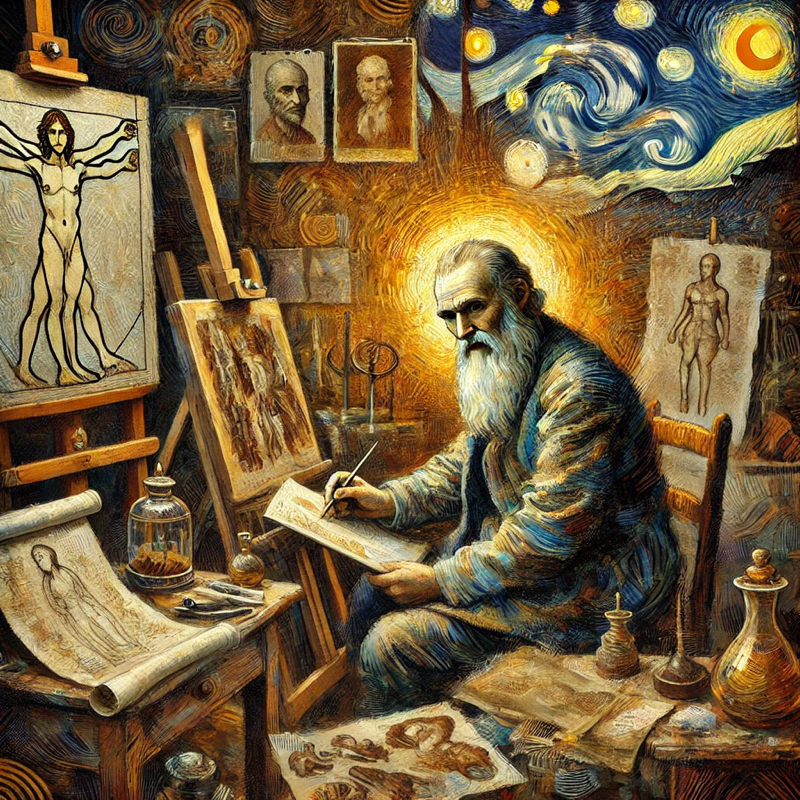Leonardo da Vinci: The Genius Who Outweighed Stigma
Leonardo da Vinci faced stigma as an illegitimate child, accusations of sodomy, and being seen as an eccentric outsider. Yet, his genius in art, science, and engineering helped him rise above these challenges, proving that true talent can overcome prejudice and leave a lasting legacy.

Leonardo da Vinci is widely regarded as one of the greatest minds in human history. His contributions to art, science, anatomy, and engineering were centuries ahead of their time. Yet, despite his immense talent, he was not free from societal stigma. Born as an illegitimate child, accused of sodomy, and often seen as an eccentric outsider, Leonardo had to navigate a world that was not always ready for his genius. However, his talent, persistence, and insatiable curiosity ultimately allowed him to rise above these challenges and secure his legacy as a true Renaissance polymath.
The Stigma of Illegitimacy
Leonardo was born in 1452 in Vinci, Italy, to Ser Piero, a respected notary, and a peasant woman named Caterina. Because he was born out of wedlock, he was barred from receiving a formal classical education in Latin and Greek, which were essential for academic and literary pursuits. This lack of formal schooling could have been a major disadvantage, cutting him off from the intellectual elite of his time. However, Leonardo was undeterred. He became largely self-taught, developing an insatiable curiosity that led him to study subjects ranging from anatomy to hydraulics. His ability to observe, question, and experiment allowed him to surpass the knowledge of many formally educated scholars.
Accusations and the Stigma of Homosexuality
In 1476, at the age of 24, Leonardo was anonymously accused of sodomy—a serious charge in Renaissance Florence, where homosexuality was a crime punishable by death or exile. Along with three other men, he was accused of engaging in relations with a known male prostitute. Though the charges were eventually dropped due to lack of evidence, the mere accusation could have damaged his reputation. Some historians believe that this event made Leonardo even more private about his personal life, leading him to avoid marriage or public relationships. Despite this cloud over his name, he continued to receive commissions and patronage, suggesting that his talent was too valuable for society to cast him aside.
The Eccentric Outsider
Leonardo’s way of thinking set him apart from his contemporaries. He was deeply fascinated by everything—from the movement of water to the anatomy of the human body. Unlike many artists of his time, he did not confine himself to one discipline. This curiosity, while extraordinary, sometimes made him seem unreliable. He had a reputation for leaving projects unfinished, such as his painting The Adoration of the Magi, and was known to be easily distracted by his scientific inquiries. This erratic nature made some patrons hesitant to commission him, but it also led to innovations that changed the course of art and science forever.
Rivalries and Court Politics
Despite his genius, Leonardo faced fierce competition. Artists like Michelangelo openly mocked him, calling him a failure for not completing certain works. Court politics also played a role in his struggles—he lost favor with the Medici family in Florence and had to move to Milan, then later to France, seeking patrons who would support his work. However, his ability to adapt ensured that he continued to receive commissions. His most famous works, including The Last Supper and Mona Lisa, were created under the patronage of rulers who recognized his brilliance.
Unrecognized Scientific Genius
Leonardo’s contributions to science and anatomy were revolutionary, yet they remained largely unknown during his lifetime. He conducted dissections and created some of the most detailed anatomical drawings ever seen, but since he never published his findings, his work did not influence the scientific community until centuries later. Similarly, his ideas on flight, hydraulics, and engineering were ahead of their time but remained hidden in his notebooks. Despite this lack of recognition, Leonardo pursued his passions relentlessly, documenting knowledge that would later astonish the world.
Talent Triumphs Over Stigma
Leonardo da Vinci’s life is a testament to the power of talent and perseverance in the face of stigma. Despite being an illegitimate child, facing accusations of sodomy, and being seen as an eccentric who often abandoned projects, he remained one of the most sought-after artists and thinkers of his time. His ability to adapt, learn, and create ensured that his legacy endured far beyond the challenges he faced in his lifetime.
Lessons We Can Learn
Leonardo’s story offers several valuable lessons:
- Curiosity is the key to growth – His relentless questioning and thirst for knowledge allowed him to master multiple disciplines.
- Resilience in the face of stigma – Despite societal challenges, he continued to push forward, proving that talent and determination can overcome prejudice.
- Versatility leads to innovation – By not limiting himself to one field, he made contributions that spanned art, science, and engineering.
- Leave a legacy, even if unrecognized in your lifetime – Though his scientific discoveries were not acknowledged then, they are now considered groundbreaking.
Conclusion
Leonardo da Vinci is celebrated as a genius who shaped art, science, and engineering in ways that continue to inspire generations. His story is a reminder that stigma, while powerful, is not absolute. True brilliance, when nurtured and pursued with passion, can rise above societal limitations and change the world.
In the end, Leonardo da Vinci was not defined by the stigma he faced but by the unparalleled vision and talent that made him immortal.
